From the October 2023 issue of Apollo. Preview and subscribe here.
Few art fairs engender much in the way of fond feelings. Frieze London, which launched 20 years ago this month, is one of the exceptions. Founded by two magazine publishers, Matthew Slotover and Amanda Sharp, then in their 30s, it was seen by many at the time as a risky – even crazy – venture. But in combination with the opening of Tate Modern three years earlier, the Frieze art fair in 2003 helped London feel as if it was swinging once again.
For starters, the fair, despite the high-value art on show, was not in a dull convention centre but in a tent designed by David Adjaye (then only 36, one of the hottest young architects around and not the controversial figure he is today). Mark Hix, a rising star at the Ivy who would go on to create his own restaurant group, including a restaurant for Damien Hirst, was in charge of the catering. Regent’s Park, an ultra-discreet area of London, was suddenly invaded by art students, actors and pop stars. Jarvis Cocker, an alumnus of St Martin’s, used the event to launch a new band, Relaxed Muscle.
At the preview, celebrities and international art collectors queued expectantly to see the galleries, artists and projects inside – including a grassy ramp by Paola Pivi which they could roll down – only to find they had been beaten to it by a horde of art-world liggers. Copious amounts of alcohol and, some hazily recall, sneaky cigarettes, were consumed as the evening wore on. At the Wrong Gallery stand, a joint project of the artist Maurizio Cattelan and curators Ali Subotnick and Massimiliano Gioni, two children were apparently being offered for sale. (It was in fact a work by performance artist Tino Sehgal.) Polly Staple, now director of British art collections at the Tate, was then an art critic and commissioned the event’s special projects. ‘When we were planning it all, we were talking about it more like a festival than a fair,’ she recalls.
Frieze is not the only London art business celebrating this year. White Cube, the gallery most associated with the British artists of the 1990s, is 30. Hauser & Wirth opened its first gallery outside Switzerland in London 20 years ago, the same year that Thomas Dane opened in St James’s. It is easy to forget that most of the contemporary art galleries we are now so used to set up in London only after Frieze. But nearly a generation on, how much do Frieze, and the British artists who inspired it, still matter?
Frieze’s roots lay in the outward-looking art scene that burst into being in London at the end of the 1980s. The Thatcher era was drawing to a close, but despite its radical cut-backs and economic restructuring, art school places were still fully funded – the artists of this generation were the last who could study art pretty much for free. Rapid deindustrialisation meant London was also filled with crumbling industrial spaces and – as the global recession of the 1990s dragged on – empty retail units: artists had cheap places to live, work and show.
By contrast, the stock market deregulation of 1986 meant that the City of London was becoming an ever-richer international financial centre, which by the end of the ’90s would see money flood into the commercial art world – just as Lottery money was driving a renaissance in the public arts sector. Meanwhile, whether they realised it or not, the artists, photographers, musicians, fashion designers, gallerists and art-fair founders who would come to define the next 20 years were Thatcher’s children: self-reliant, risk-taking and entrepreneurial.
It is hard to imagine Frieze, the art fair, without ‘Freeze’, the exhibition (the homonym was surely no coincidence). In 1988, Hirst mounted the show in a former port authority building close to the Surrey Docks on the Thames in south-east London. Sixteen graduates, most of them from Goldsmiths, showed eye-catching work, most memorably Mat Collishaw’s huge photographic Bullet Hole (in fact, the image of an ice-pick hole in a human head) and a poured-lead floor sculpture by Anya Gallaccio.
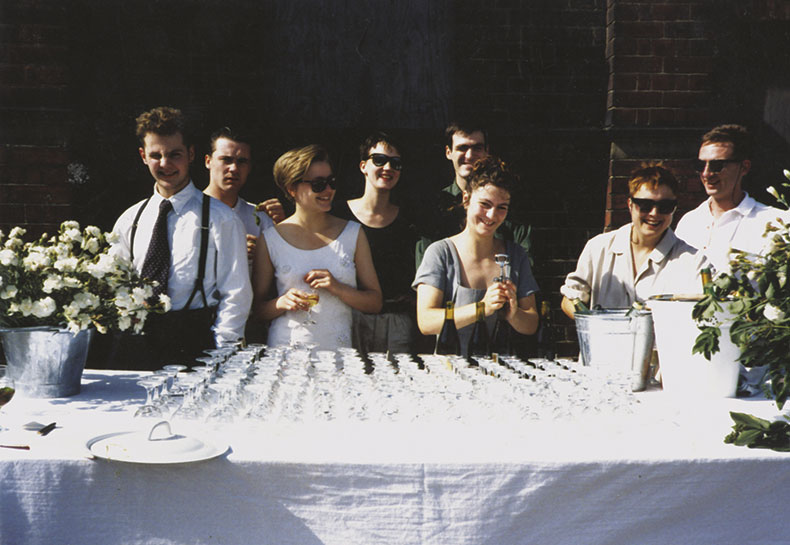
The YBAs in 1988 at a private view for ‘Freeze’: Ian Davenport, Damien Hirst, Angela Bulloch, Fiona Rae, Stephen Park, Anya Gallaccio, Sarah Lucas and Gary Hume. Photo: Abigail Lane; © Abigail Lane. All Rights Reserved, DACS/Artimage 2023
Todd Levin, a New York-based art adviser now most associated with blue-chip artists, often came to London in the period – for the Docklands acid-house music scene more than the art. Early in 1990, he recalls, the art market followed the crashing stock market. ‘It was like nuclear winter. But in east London I was going to these big, empty, foreboding warehouses and experiencing DIY exhibitions of art that were astonishing,’ he says.
Levin was not the only US convert. In 1992 Barbara Gladstone Gallery in New York put on ‘Twelve British Artists’, including Hirst, Sarah Lucas, Marc Quinn and Marcus Harvey. Three years later Richard Flood, chief curator of the Walker Art Center in Minneapolis, mounted a bigger version of the show, ‘Brilliant! New Art from London’. Not everyone in the United States was impressed, however, and even Flood recalls that some of the work he saw on London studio visits was ‘tawdry’ and ‘disposable’.
According to Massimiliano Gioni, the Frieze Art Fair marked the point that the international art world really started to notice the London art world’s transformation. ‘Frieze heralded a bigger art world, one that was maybe more globalised and more connected,’ he says. ‘There was a certain pride, of course, in British culture – all the museums in the city were putting up shows too, to be part of the fair. But there was a sense that London was becoming more international, more global, and it wouldn’t be the same again.’
New contemporary galleries also started to emerge in London – many involved with these rising artists. In 2002 Norman Rosenthal, the Royal Academy’s exhibitions secretary, decided to celebrate the fact, mounting ‘The Galleries Show’ at the museum. It presented works of art from 20 commercial London galleries, including Gagosian (which had opened in London two years before), Lisson, Victoria Miro, Frith Street, Sadie Coles HQ, Stephen Friedman, The Approach and Vilma Gold. For Max Wigram, the show’s co-organiser, it made sense because ‘Ninety-nine per cent of progress in art takes place in [commercial] galleries.’
Much of the flavour of the era was captured in Lucky Kunst: The Rise and Fall of Young British Art (2013), a memoir by Gregor Muir. Then a hedonistic partygoer who knew most of the artists and gallerists involved, Muir is now the director of the Tate’s international collections. Only 12 pages of his book are devoted to documenting the fall of the YBAs as a group, but it would be fair to say that even by 2003 a lot of people had had enough of them. Muir recalls the moment around 2001 when he realised ‘the slightly worn packaging of YBA [would be] eventually tossed out of the car window […] The art world [would soon go in] search of emerging artists in Berlin, Warsaw and Beijing.’ The first Frieze fair tapped into that internationalist spirit: fewer than a third of the galleries showing were based in the UK. Most did not focus particularly on British artists.
Twenty years on, the period is ripe for reassessment. Hirst, the most famous and financially successful YBA, continues to take most of the flak. His recent exhibition of Expressionist paintings, ‘Where the Land Meets the Sea’, at Phillips, was dismissed by The Times as ‘pleasant’, and many chose not to even review it. It also earned him the sobriquet MBA (middle-aged British artist). Some of the works in Charles Saatchi’s exhibition of 1997, ‘Sensation’ – especially those most designed to shock, such as Marcus Harvey’s Myra (1995) – now look tasteless and dated.
The laddish, headline-grabbing, look-at-me-antics of the 1990s are certainly out of fashion. Nowhere has that been more apparent than at the annual Turner Prize, the Oscars of the YBA era. In 2019 the four shortlisted candidates – Oscar Murillo, Lawrence Abu Hamdan, Tai Shani and Helen Cammock – decided to split the prize among themselves. The reason, they said, was that it was inappropriate ‘if we were pitted against each other, with the implication that one was more important, significant or more worthy of attention than the others’.
Gioni, now artistic director of the New Museum in New York, sees this as a common tendency. ‘The 1990s was a moment when the persona of the artist became a medium of expression, a playground for art, in itself,’ he says. This was not just in London, but also apparent in the work of artists such as Cattelan in Italy and Matthew Barney in New York. ‘Younger artists are much more troubled by that visibility,’ he says. ‘There’s a fascination now for the inscrutable, the mysterious and the complicated much more than the popular,’ he adds, pointing to British artists such as Ed Atkins, James Richards and Helen Marten.
Many of the hot young things of the early 1990s have disappeared from view: Harvey, Henry Bond, Steven Pippin and Simon Callery, for example, may still be working but are hardly household names. Others now look like one-hit wonders: Marc Quinn’s blood head, Self (1991); Gavin Turk’s sculpture of himself as Sid Vicious, Pop (1993); Simon Patterson’s altered map of the London Underground, The Great Bear (1992). A lot of YBA work now seems, as the critic Matthew Collings once put it, less profound provocation and more ‘punky daftness’.
Nevertheless, it is hard to see how the story of international art will be written without at least some of them. Hirst’s place in history is surely secure, especially for his early work, and for making art that both manipulated and commented on the art market. He remains a financial powerhouse. No one outside Science, the company he set up to manage his output, knows the true scale of his market. In 2013, White Cube told research firm ArtTactic that Hirst had sold more than $100m on the primary market the previous year, but that is impossible to verify. Work by Hirst made more than $40m at auction last year, a huge sum for a supposedly unfashionable artist, although that is dwarfed by the $223m of 2008, which included his straight-to-auction consignments for his ‘Beautiful Inside My Head Forever’ auction.
Meanwhile the 1990s and 2000s are undergoing a wider critical evaluation. Sarah Lucas’s retrospective ‘Happy Gas’ has just opened at Tate Britain (until 14 January). Tracey Emin recently opened her artist’s residency programme in Margate, created new bronze doors for the National Portrait Gallery this summer, and will have a major commercial exhibition with White Cube this year. They are both benefiting from the current demand for women artists.
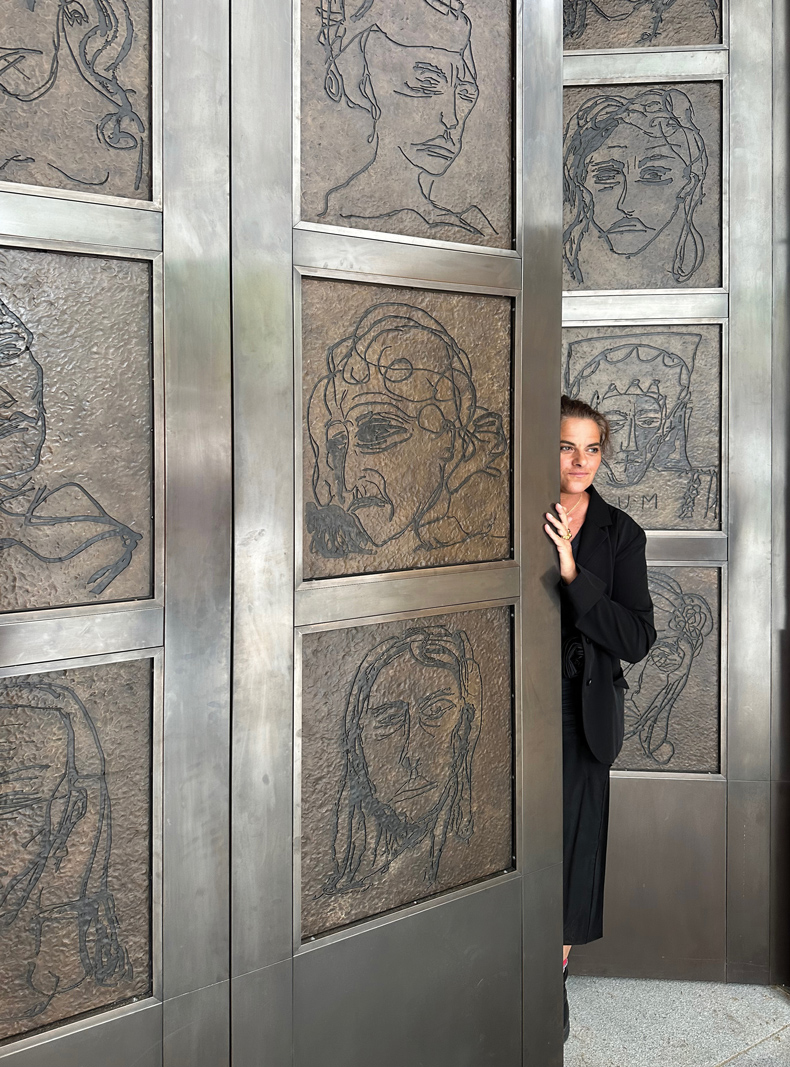
Tracey Emin standing next to The Doors (2023) at the National Portrait Gallery, London. Photo: Harry Weller
But it is artists of a similar age to the YBA group but who were not associated with them – including British film-makers Isaac Julien, John Akomfrah and Steve McQueen – who are currently some of the most admired on the international stage. The 55-year-old German photographer Wolfgang Tillmans, meanwhile, who first moved to Bethnal Green in London in 1992, had a major retrospective at the Museum of Modern Art, New York, last year. It is currently showing at the Art Gallery of Ontario in Toronto, before it moves to the San Francisco Museum of Modern Art next year.
‘The YBA story – which was a very Anglo-American model coming out of Pop art – preoccupied the media and the market,’ Staple says. ‘Part of my curatorial role at the Tate is to look back and recognise the many other artists working at the time, including Black British artists, who were not part of the dominant narrative.’
Frieze London, meanwhile, is a very different beast from its 2003 incarnation. Endeavor, a giant US entertainment company that owns World Wrestling Entertainment, Miss World and the sports management firm IMG, bought a 70 per cent stake in 2019. Frieze now embraces historic art at Frieze Masters, and runs fairs in New York, Los Angeles and Seoul. In July it was announced that Frieze was also buying the Armory Show in New York and Expo Chicago. Inevitably, as the fair has grown, it has become more professional, more upmarket, more sleek and, some say, more corporate and dull.
Perhaps the most noticeable change since the 1990s has been in London’s commercial contemporary art scene. The tiny group of ’90s galleries – Lisson, Maureen Paley, Sadie Coles HQ, Karsten Schubert et al. – has now swollen to number about 300. The galleries are also much more international: White Cube, the gallery most associated with the YBAs, has just opened a new gallery in New York and its roster of artists comes from around the world.
In 2021 Sharp and Slotover recalled that in the 1990s ‘the [entire contemporary] London art world could fit in a single pub’ – indeed, after openings at galleries such as Anthony d’Offay’s in Mayfair, it often did. Had you said to one of the none-too-sober attendees that within a few years London would have a contemporary art scene as large and as rich as New York’s, you would have been greeted with a snort of derision – and an unprintable reply.
From the October 2023 issue of Apollo. Preview and subscribe here.
Unlimited access from just $16 every 3 months
Subscribe to get unlimited and exclusive access to the top art stories, interviews and exhibition reviews.

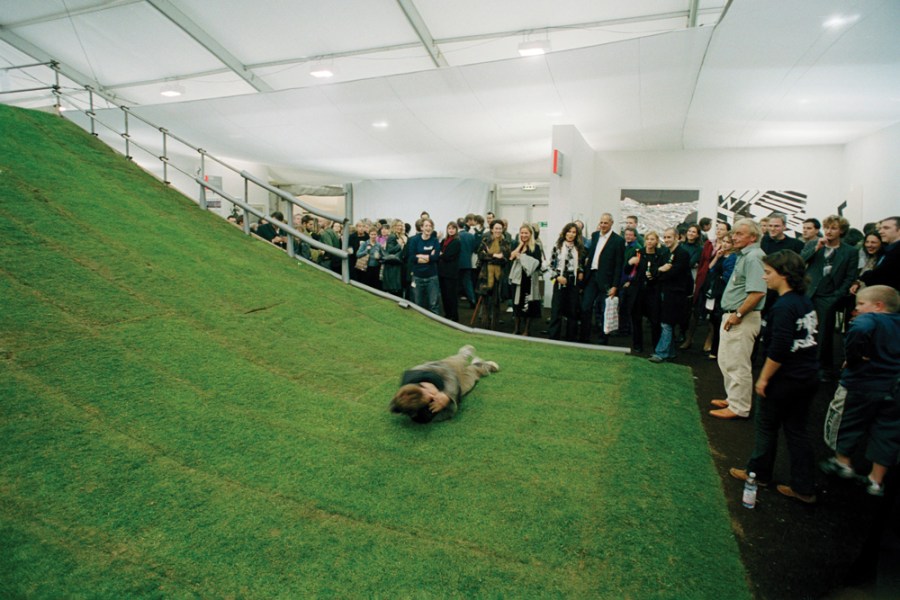
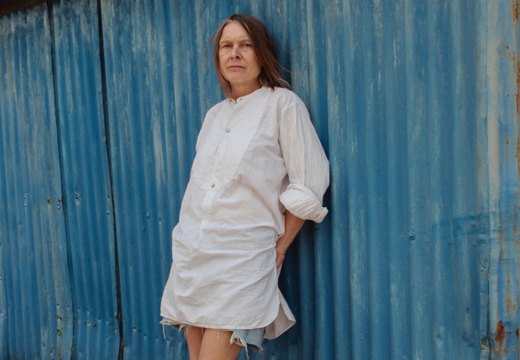
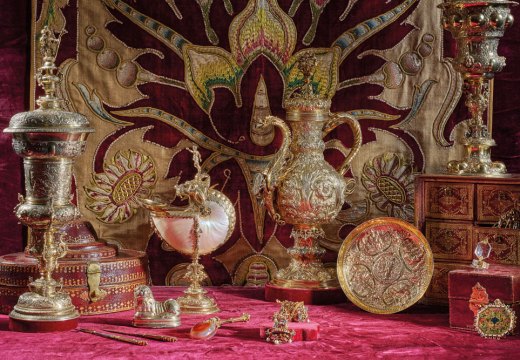
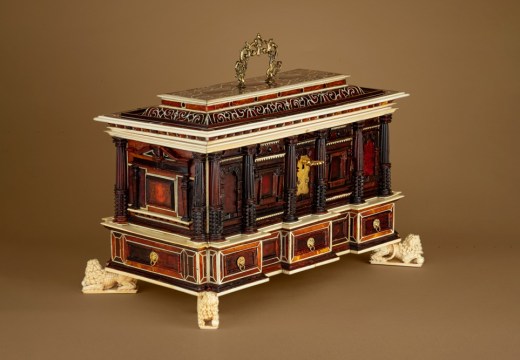









![Masterpiece [Re]discovery 2022. Photo: Ben Fisher Photography, courtesy of Masterpiece London](http://www.apollo-magazine.com/wp-content/uploads/2022/07/MPL2022_4263.jpg)
It’s time for the government of London to return to its rightful home